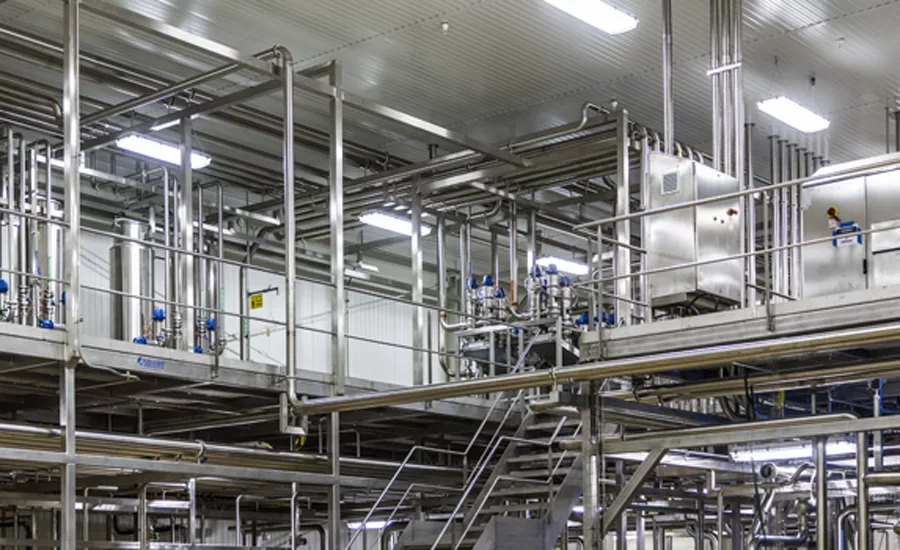TECH FLASH
Using pinch valves in the food and beverage industry
Pinch valves offer significant ways to automate, service and increase production efficiency while ensuring consumer safety remains the top priority

Perhaps the single most important focus in the food and beverage industry is ensuring products are created, packaged and consumed in the safest way possible. Automation equipment that handles these products plays an integral role in the overall quality of the material being processed. However, the introduction of unwanted materials into food and beverages is an inevitable, captured part of the production process. For example, as a product is processed through handling equipment, it can move through a series of pumps, motors, valves, sensors and fittings, where lubricants such as O-ring grease can come into direct contact with it. FDA has clear guidelines on contaminants, which, at acceptable levels, are known to not cause harm.
Ensuring a product is free of harmful bacteria is also a primary concern for any food or beverage manufacturer. For instance, E. coli and Salmonella are naturally occurring bacteria that are present in and around many food and beverage products. Both can be introduced into automation equipment when the food or beverage material is in direct contact with the processing components. However, newer automated system designs that employ prepacked, sterilized, FDA-approved tubing or membrane bags can offer a new alternative for potentially reducing bacterial contamination. In this case, possible contamination is further reduced by using a pinch valve that interacts with the tubing and never touches the beverage or food media being processed.
Components on automated systems are routinely cleaned, serviced and replaced at food and beverage plants. With traditional systems, where the composition of the component material is in direct contact with the food or beverage, a pause or shutdown of the line is needed to complete periodic cleaning or service. By utilizing components such as pinch valves, along with tubing or membrane barrier material, servicing or replacing that component becomes a quick and easy task. A pinch valve can be quickly serviced or replaced without a complete shutdown and re-cleaning of the line which can maximize productivity and reduce costs.
Pinch valves can also be designed for full washdown cleaning or sterilization procedures that don’t require them to be removed from equipment. For example, a similar market, biopharm, uses traditional stainless steel equipment for bioreactor cell growth and downstream processing. Newer technological advancements over the past 10 years have spawned a new method that uses single-use disposable technologies, referred to as “SUD” or “SUT.” These have been adopted by pharma manufacturing as an effective alternative and complement to traditional methods. SUDs utilize disposable, closed membrane bags and tubing while traditional systems had the media running in direct contact through many wetted components.
A recent study conducted by GE’s Eco-assessment Center of Excellence, Resource & Environmental Strategies compared the two approaches in terms of generated waste material. It was discovered that traditional processes use far more energy to sterilize and decontaminate, making them the largest contributors to waste, cost and negative environmental impacts. Consequently, food and beverage, an industry that shares similar needs as biopharm to ensure non-contamination, may also benefit from the use of disposable consumables like SUDs in its applications.
Pinch valve performance is primarily determined by type. Electric-solenoid and air-pneumatic valves are designed to work effectively with different linear force output capacities and sizes of tubing or membrane bag material. Solenoid pinch valves are generally sized to work with tubing up to 7/16 in. in outer diameter, durometers of 65A and average media pressures of 20 to 30 psi. Pneumatic pinch valves, on the other hand, can work with tubing up to 1.6-in. OD, durometers up to 75A and media pressure up to 80 psi. Each application should be examined to determine how the tube sizing, hardness and media pressure would impact valve choice.
Effective alternative technologies and improvements such as pinch valves offer system designers significant ways to better automate, service and increase production efficiency in future systems while further ensuring product safety remains the top priority. Pinch valve technology is well established and has been around for decades, however recent technology advancements can make them a compelling new consideration against other technological approaches.
Highly regulated markets such as biopharm have been at the forefront of this trend. Drug and biological manufacturing share many similar concerns and needs, which have spawned a high-growth focus on new application areas known as single-use disposable consumables and systems for bioprocessing applications. When one begins to think of the multitude of food and beverage applications such as beer, wine, creamery, soup, soda, juices and many others where contamination and food safety are paramount, we can see where pinch valves might play a future role in improving manufacturing efficiencies and overall product quality.
Looking for a reprint of this article?
From high-res PDFs to custom plaques, order your copy today!






